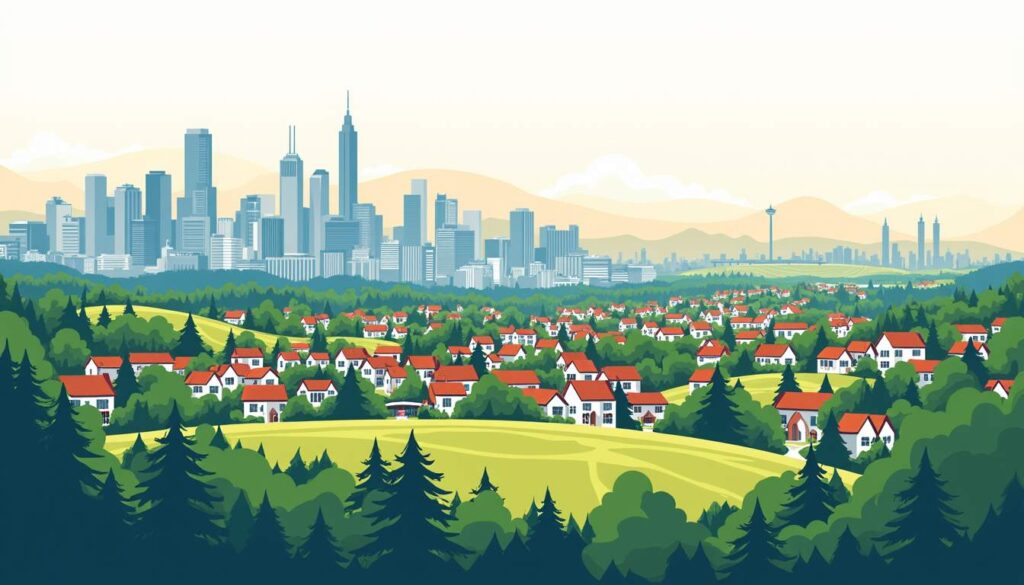As the world continues to evolve, so do the preferences and priorities of its inhabitants. In 2025, a noticeable shift is occurring in the United States as many Americans are opting to leave bustling urban centers for quieter, more serene locales. This article delves into the reasons behind this trend and highlights the destinations that are becoming increasingly popular among those seeking a change.
The Urban Exodus: Understanding the Trend
The trend of leaving big cities isn’t entirely new, but it has gained momentum in recent years. Factors such as the COVID-19 pandemic, remote work opportunities, and the rising cost of living have all contributed to this migration. As people reassess their lifestyles, the allure of suburban and rural living becomes more pronounced.
Remote Work Revolution
The pandemic accelerated the adoption of remote work, allowing individuals to live anywhere while maintaining their jobs. This newfound flexibility has empowered many to seek out homes in areas that offer a better quality of life, often at a fraction of the cost of urban living. With the ability to work from anywhere, the traditional ties to cities are loosening, enabling a more diverse range of living options.
As companies embrace hybrid models, employees are no longer tethered to their offices. This shift has prompted a reevaluation of what constitutes a desirable living environment. For many, the hustle and bustle of city life is being replaced by the tranquility of nature, spacious homes, and a stronger sense of community. Additionally, the rise of digital nomadism has led to a surge in interest for locations that offer not just affordability, but also a vibrant local culture, outdoor activities, and a sense of belonging. Places that were once considered off the beaten path are now becoming hotspots for those looking to blend work and leisure seamlessly.
Cost of Living Concerns
Another significant factor driving the move away from big cities is the skyrocketing cost of living. Cities like San Francisco, New York, and Los Angeles have seen exorbitant increases in housing prices, making it increasingly difficult for many to afford even a modest apartment. In contrast, smaller towns and cities offer more affordable housing options, often accompanied by lower overall living expenses.
As more individuals and families seek to stretch their dollars further, they are discovering that smaller cities and towns can provide not only affordability but also a higher quality of life. Access to outdoor activities, lower crime rates, and a slower pace of life are enticing many to make the leap. Moreover, the sense of community found in these areas often fosters deeper connections among residents, leading to a more supportive environment. Local businesses thrive as new residents bring fresh ideas and energy, creating a dynamic atmosphere that celebrates both tradition and innovation. This revitalization of smaller communities is reshaping the landscape of American living, where the focus is increasingly on sustainability and quality over sheer quantity.
Top Destinations for Relocation
As Americans bid farewell to big cities, several regions are emerging as popular destinations for those seeking a fresh start. These areas offer a blend of affordability, community, and natural beauty, making them attractive options for a variety of lifestyles.
1. Austin, Texas
Austin has long been known as a vibrant tech hub with a lively music scene, but it has also become a sanctuary for those fleeing larger urban areas. The city’s unique blend of culture, innovation, and outdoor activities makes it a compelling choice for many. With a relatively low cost of living compared to other major cities, Austin attracts young professionals, families, and retirees alike.
The city’s commitment to maintaining green spaces, coupled with its thriving local economy, ensures that residents can enjoy a high quality of life. Additionally, the warm climate and numerous recreational opportunities further enhance its appeal.
2. Boise, Idaho
Boise has emerged as a surprising favorite among those looking to escape the chaos of city life. Nestled in the foothills of the Rocky Mountains, this city offers stunning natural landscapes, outdoor activities, and a strong sense of community. The cost of living in Boise remains relatively low, especially when compared to coastal cities.
Boise’s charm lies in its ability to provide a small-town feel while still offering the amenities of a larger city. With a growing food scene, cultural events, and access to nature, it’s no wonder that many are flocking to this Idaho gem.
3. Asheville, North Carolina
Asheville is often heralded as a hidden treasure in the Appalachian Mountains. Known for its vibrant arts scene, historic architecture, and breathtaking scenery, this city has become a magnet for those seeking a slower pace of life. The cost of living is reasonable, and the community is welcoming, making it an attractive option for newcomers.
Outdoor enthusiasts will find plenty to love in Asheville, with access to hiking, biking, and stunning mountain views. The local culture, characterized by a strong emphasis on sustainability and local businesses, further enhances the city’s appeal.
Factors Influencing the Move
The decision to leave big cities is influenced by a variety of factors that extend beyond mere preferences. Understanding these influences can provide insight into the motivations behind this significant shift in living patterns.
Health and Wellbeing
Health concerns have taken center stage in recent years, prompting many to prioritize their physical and mental well-being. The crowded nature of urban environments can be stressful, leading individuals to seek out quieter, more peaceful surroundings. Smaller towns often provide a more relaxed atmosphere, which can contribute to improved mental health.
Access to nature is another crucial aspect of this trend. Many studies have shown that spending time outdoors can reduce stress and enhance overall well-being. As people move to areas with abundant green spaces and outdoor activities, they are likely to experience a positive impact on their health.
Family and Community
For families, the desire for a strong sense of community is paramount. Big cities can often feel isolating, with a fast-paced lifestyle that leaves little room for connection. Smaller towns tend to foster closer relationships among residents, creating a supportive environment for families.
Additionally, the availability of quality schools, parks, and recreational facilities plays a significant role in attracting families to these areas. Parents are increasingly seeking environments where their children can thrive, both academically and socially.
The Future of Urban Living
While the trend of moving away from big cities is evident, it doesn’t necessarily spell doom for urban living. Cities are likely to adapt and evolve in response to these changes. Urban planners and policymakers may focus on creating more livable spaces that prioritize health, sustainability, and community engagement.
Revitalization of Urban Areas
As some residents leave, cities may find opportunities to revitalize neighborhoods and improve quality of life for those who remain. Investments in public spaces, transportation, and affordable housing can help attract new residents and retain current ones. Cities may also focus on enhancing green spaces and promoting local businesses to create a more inviting atmosphere.
Hybrid Living Models
The rise of hybrid living models, where individuals split their time between urban and rural settings, is also likely to gain traction. This approach allows people to enjoy the benefits of both worlds, maintaining a connection to the vibrancy of city life while also enjoying the tranquility of rural living.
Conclusion: Embracing Change
The migration away from big cities represents a significant cultural shift in America. As individuals and families seek out new opportunities for health, happiness, and community, the landscape of living options continues to evolve. While big cities will always hold a certain allure, the appeal of smaller towns and suburban areas is undeniable.
As this trend unfolds, it will be fascinating to observe how cities adapt to the changing needs of their residents. The future of living in America is likely to be a blend of urban and rural experiences, creating a diverse tapestry of lifestyles that cater to a wide range of preferences and priorities.
















